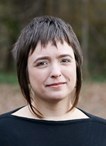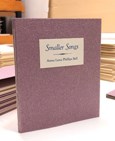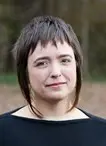The Ghost of Form: An Interview with Anna Lena Phillips Bell
by Hope Fischbach


Hope Fischbach: Could you share with us a glimpse of your writing process for Smaller Songs?
Anna Lena Phillips Bell: A few years ago I bought a copy of English and Scottish Ballads at the beloved, now gone, Bookshop of Chapel Hill. (Side note: boycott Amazon!) I picked up the book because it was appealing—a pink cover with a swan—and because I do love a ballad, and because the footnotes, written by Robert Graves, who had edited the collection, were sparse but entertaining. Over the course of a long winter, I transcribed the footnotes onto little cards, and then sorted the words within them alphabetically so that I had a word bank. As I worked, they seemed to want to coalesce into phrases, and those phrases tended toward the little poems that make up Smaller Songs. I did a lot of cutting up and moving around of the little units of verse, so the project is a collage, of a kind.
HF: How does the history of—and your subversion of—English and Scottish ballads intertwine with Appalachian music and culture? Could you tell us more about the relationship between Smaller Songs and Ornament, your first book?
ALPB: A lot of Ornament is in conversation with old-time songs and tunes, including a few ballads. I began making the poems that became Smaller Songs partly in irritation at some of the strictures and tropes of the ballads reprinted in English and Scottish Ballads, and at Graves’s interpretations of them—and partly in pure glee at the language I found there.
HF: In Issue 28 of Ecotone, your introduction “The Work of Love” states, “One of my great loves, and one of this magazine’s abiding concerns, is print culture—the way editing, design, and materials can come together to make enduring text objects.” It’s clear that a similar concern presided over the design of Smaller Songs, consistent with your love for the craft of books. Can you tell us more about the choices for the chapbook’s physical design (the woodcuts, color, type, and material)?
ALPB: I feel really fortunate that Smaller Songs has a home with St Brigid Press, which helped the book find its life as an object. Emily Hancock, the publisher, has a fantastic sensibility, and I love her values as a printer. Our conversations about trim size and cover paper and interior type and sewing were so much fun. We had talked about finding a few illustrations for the book, and around that time I happened to be calling a New Year’s Eve square dance, for which my friend Molly Stouten was playing fiddle. Molly has a long practice as a visual artist and a book artist, and on a New Year’s Day walk, she offered to make woodcuts for the frontispiece and section headings. I love the feeling she captures in each of them, and the way Emily incorporated them into the book.
HF: How does your experience as a square-dance caller influence your perception of music and movement in poetry? Is there a kinesthetic element to your writing practice?
ALPB: What a fantastic question. My poetic practices and my movement practices feel like part of the same continuum. There is something pleasing to me about the structure of a square dance—that the dancers collectively make these patterns with their bodies. Something that’s important to me as a caller, and as a person in a body generally, is finding freedom from thinking of gender as binary, and from the unwanted associations that come with that binary. It’s why I call almost all the dances I know without reference to gender. Square dancing, like the old-time music that often accompanies it, has oppression in its history; like old-time, it also has joy, and complexity, and weirdness, and its particular joys and weirdnesses are things I love deeply. In thinking about poetic form, too, I think of the ways meter and form were used to carry on the status quo, but also of the ways meter and form feel in my body, ways I find them useful now.
The pleasure I take in square dancing is probably the same pleasure I take in writing poems in fixed forms—a structure that feels very physical. Poems, especially patterned ones, become part of our bodies when we express them physically. They become part of us and they change us. Even the poems that make up Smaller Songs have the ghost of a stanzaic form, and of ballad meter, in them.
HF: Could you discuss the significance of the garden, the knife, and the inner room as thematic elements?
ALPB: As I revised, I found the poems coalescing around those three broad ideas—of growing and nourishment and the household; of violence, specifically violence done by men; and of the inner spaces, both physical and psychic or emotional, that women and other people of marginalized genders have created to sustain themselves.
HF: The collection’s first poem ends with the single word “magic”; the last poem in Smaller Songs ends with the phrase “alive to myself.” Throughout the collection, it seems that magic has much to do with observation, and in turn that observation has much to do with being alive to oneself. What kinds of observations do you hope your readers will draw from this collection?
ALPB: I hope the book proposes, or reminds of, the right to be alive to oneself—to live and thrive in cultures that may not consistently affirm our agency. The people whose lives (real or imagined) made it into traditional ballads were constrained by ideas about gender and class and race—and often magic, or something like it, is there to remind us that there is more at work in the world than those structures.
HF: Who is the speaker of these poems? Is there more than one?
ALPB: Me, sometimes; sometimes maybe it’s the voice of the ballads talking to me. Or me giving advice to myself. The speakers are steeped in the world of the old ballads, but not constrained by that world; they’re able to reinvent it.
HF: Why did you choose the poem “Manage cheerfully…,” from “Songs of the Garden,” to set to music?
ALPB: My partner, Allen Phillips Bell, and I chose it together—he wrote the music. The poem worked well metrically for a song, and we liked the symmetry of the four lines. And it was lighter in tone than some of the other poems we considered. He wrote a harmony line for it too, and when we sing it together I keep time with a kids’ rhythm instrument that’s basically jingle bells on a stick. It seems appropriate for the song’s marrying of solemnity and, well, cheer.
HF: Do you have a favorite revision strategy?
ALPB: I like having all the revisions of a poem printed out, held together with a paper clip or a binder clip; I print out each version after I’ve revised it. If I try to revise on screen only, my hands and the machine move faster than my brain and I lose things. I used to type each draft on my Smith-Corona Silent; I still like to do that, especially for early versions. It’s important to let the lines live in the physical world.
HF: What are you working on now?
ALPB: I’m working on a collection that includes poems in support of plant communities, as well as notes to self on labor and rest, living in a time of climate crisis, and inhabiting a female body. I’m also in the process of revising and expanding a portable craft guide, A Pocket Book of Forms.
HF: What advice would you offer to students interested in creative writing?
ALPB: Make stuff! Make lots of stuff. Also, be rigorous about learning elements of craft—for poetry, fixed forms old and new, meter, strategies for enjambment. Find ways to interact with older texts that allow you to do something new with them. Be kind to your work—especially when it’s new, don’t treat it harshly. And later, be kind by being clear and thorough and wildly enthusiastic about revision. But mostly, make room in your life for the pleasure of making poems, and of reading lots of other people’s.
Anna Lena Phillips Bell is the author of Ornament, winner of the Vassar Miller Poetry Prize, and the chapbook Smaller Songs, from St. Brigid Press. Her artist’s books, including A Pocket Book of Forms, a travel-sized guide to prosody, have been selected for exhibitions at Abecedarian Gallery and Asheville Bookworks. The recipient of a North Carolina Arts Council Fellowship in literature, and the winner of the 2021 Winter Anthology Contest, she teaches in the creative writing department at UNC Wilmington and is the editor of Ecotone.
Hope Fischbach is a fifth grade teacher and freelance writer based in Corpus Christi, Texas. She holds a BA in English and Spanish from Lee University in Cleveland, Tennessee. Her work has appeared in Grist, Whale Road Review, Cleaver Magazine, 30 North Literary Review, EcoTheo Review, and elsewhere.

